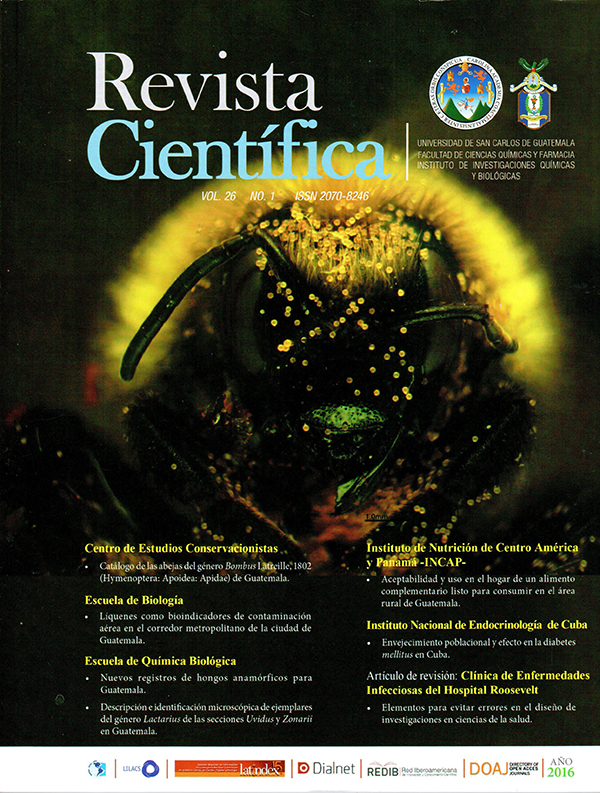Microscopic description and identification of specimens of the genus Lactarius of the sections Uvidus and Zonarii in Guatemala
DOI:
https://doi.org/10.54495/Rev.Cientifica.v26i1.81Keywords:
Lactarius, Uvidi and Zonarii section, NeotropicAbstract
The genus Lactarius (Basidiomycetes) is distributed worldwide and is characterized by colorful basidiomata, which exude latex. On this study were analyzed, with the purpose of identifying the species where they belong. 28 dried mushroom samples of Lactarius, attached to Uvidus and Zonarii Sections, collected in Guatemala and placed at the Micoteca “Rubén Mayorga Perlata”-MICG- (herbarium) of the Faculty of Chemistry and Pharmacy, University of San Carlos of Guatemala. Spores, their crests and Q index were analyzed (length / width ratio). It also was analized the size of basidia, sterigmata, pleurocystidia, cheilocystidia, and pilleipelis structure; as well were analyzed qualitative characteristics such as microstructures reaction of Melzer’s reagent and presence incrustations in hyphae. It was found that the microstructures of six samples match in shape and dimensions with Lactarius mexicanus, L. psammicola, L. chrysorheus. 23 are related to L. uvidus. This study confirms the presence of species In Guatemala which were only reported in North America such as L. montanus, L. mexicanus or separately reported in Costa Rica as L. psammicola.
Downloads
References
Basso, T. (2005). Manual di Microscopia dei Funghi. Alassio: Mykoflora.
Bessette, A., Harris, D., & Bessette, A. (2009). Milk Mushrooms of North America. New York: Syracuse University Press.
De la Osa, L. (2003). Setas del Parque Natural de Aracena y Picos de Aroche. Huelva: Diputación de Huelva.
Flores, R., Díaz, G., & Honrubia, M. (2005). Caracterización de cepas de Lactarius Sección Deliciosi de Guatemala y su comparación con cepas europeas de L. deliciosus. Revista Mexicana de Micología, 26(1), 51-55.
Flores, R., Díaz, G., & Honrubia, M. (2005). Mycorrhizal synthesis of Lactarius indigo (Schw.) Fr. with five Neotropical pine species. Mycorrhiza, 15(1), 563–570. https://doi.org/10.1007/s00572-005-0004-y DOI: https://doi.org/10.1007/s00572-005-0004-y
Flores, R., Díaz, G., & Honrubia, M. (2007). Lactarius section Deliciosi in Guatemala: a clue to understand the puzzle. The Fifth International Workshop of Edible Mycorrhizal Mushrooms. Chuxiong, China.
Fries, E. (1838). Epicrisis Systematis Mycologici, seu Synopsis, Hymenomycetum, Upsala. Suecia; 1-610.
García, J. (2013). Diversidad de macromicetos en el Estado de Tamaulipas, México (Tesis Doctoral). Facultad de Ciencias Forestales, Universidad Autónoma de Nuevo León. México.
Halling, R., & Mueller, G. (2005). Common Mushrooms of the Talamanca Mountains. New York: New York Botanical Garden.
Hesler, L., Smith, A., Homola, R., & Weber, N. (1979). North American Species of Lactarius. Michigan: University of Michigan Press.
Heilmann-Clausen, J., Verbeken, A., & Vesternhoft, J. (2000). The Genus Lactarius. (Vol. 2). Mundelstrup, Denmark: Skive Offset.
Kong, A., & Estrada, A. (1994). A new species of Lactarius from Mexico. Mycotaxon, 52(2), 443-466.
Kuo, M. (2004). 100 Edible Mushrooms. Michigan: The University of Michigan.
Kuo, M. (2011). Lactarius psammicola. Recuperado de http://www.mushroomexpert.com/lactarius_psammicola.html
Mata, M., Halling, R., & Mueller, G. (2005). Macrohongos de Costa Rica. Heredia: INBio.
Montoya, L., Guzmán, G., & Bandala, V. (1990). New Records of Lactarius from México and discussion of the known species. Mycotaxon, 26, 349-395.
Montoya, L., & Bandala, V. (2003). Studies on Lactarius: A new combination and two new species from Mexico. Mycotaxon, 85, 393-407.
Silva, P., & Acosta, A. (1985). Micoflora del Estado de Durango, México. Revista Mexicana de Micología, 1, 315-329.
Downloads
Published
How to Cite
Issue
Section
License
Copyright (c) 2016 Carlos Porras, Roberto Flores

This work is licensed under a Creative Commons Attribution 4.0 International License.
Authors who publish with this journal agree to the following terms:
- Authors retain copyright and grant the journal right of first publication with the work simultaneously licensed under a Creative Commons Attribution License 4.0 that allows others to share the work with an acknowledgement of the work's authorship and initial publication in this journal.
- Authors are able to enter into separate, additional contractual arrangements for the non-exclusive distribution of the journal's published version of the work (e.g., post it to an institutional repository or publish it in a book), with an acknowledgement of its initial publication in this journal.
- Authors are permitted and encouraged to post their work online (e.g., in institutional repositories or on their website) prior to and during the submission process, as it can lead to productive exchanges, as well as earlier and greater citation of published work.









